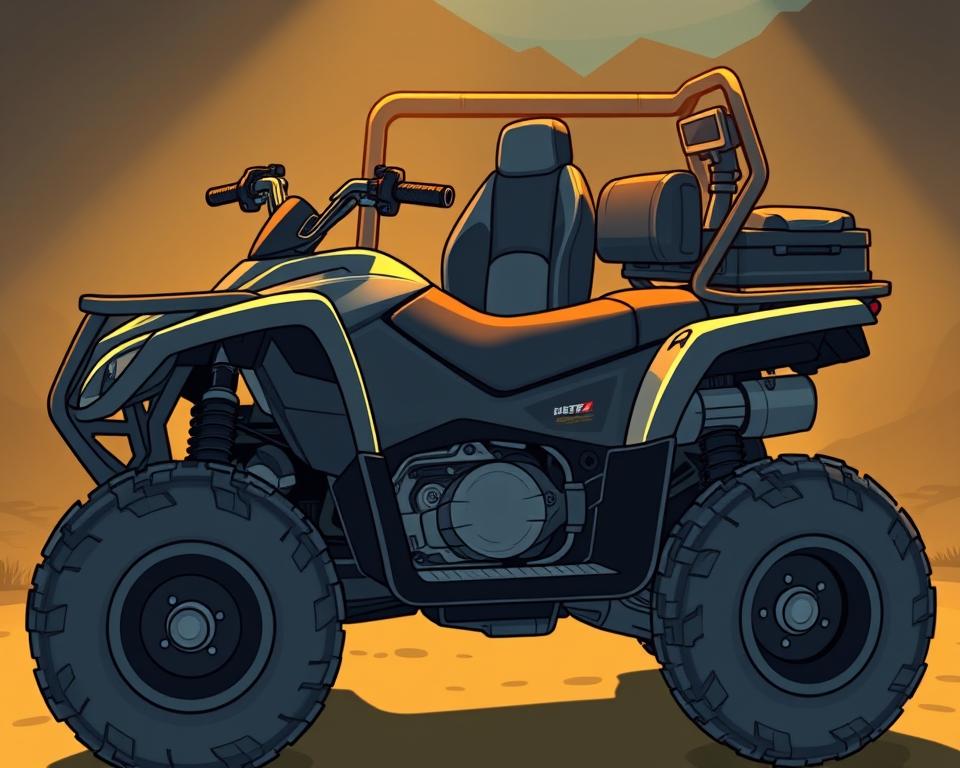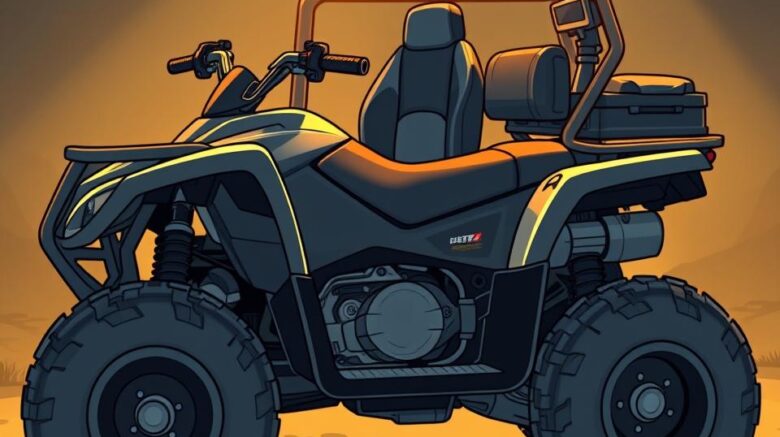Steering Clear of ATV/UTV Gearing Errors for Novices
Can you believe that nearly 35% of new ATV and UTV owners face gear selection issues within their first year? This statistic underlines the importance of grasping ATV gear ratios for beginners. It’s not just about performance; it’s also about safety on the trails. In this guide, we cover typical errors, upkeep tips, and pro ATV and UTV accessories recommendations for better trail experiences.
Principal Conclusions

- Understanding gear ratios is vital for optimal ATV/UTV performance.
- Typical gear mistakes compromise safety on uneven ground.
- Scheduled upkeep stops gearbox failures.
- Smart gear choices transform your outdoor rides.
- Following upkeep advice extends your ATV’s life.
Understanding ATV and UTV Gear Ratios
Ratios determine how engine output translates to drive force. They govern both top speed and hauling capacity. That impacts hill climbs and tow capabilities. Custom gearing shifts focus from speed to torque or vice versa.
Selecting proper gears unlocks engine potential. A low gear ratio can hinder torque during steep climbs or when carrying heavy loads. Conversely, too high a ratio hampers quick takeoffs on flats.
Many enthusiasts use gear reduction to enhance handling and adaptability across different terrains. By adjusting gear ratios, riders can customize their vehicle’s performance. It lets you balance acceleration with pulling force. Finding the sweet spot in gearing enhances ride quality and fuel economy.
Common Gearing Oversights for New ATV/UTV Owners
Correct gearing secures top output and trail safety. Many new owners overlook critical aspects of gear selection. Understanding the effects of wrong gear choices and selecting the right one for your terrain can greatly improve your ride. It also helps avoid issues.
Impact of Incorrect Gear Selection
Choosing the wrong gear can lead to serious problems, including loss of control and mechanical failures. Poor gear choice dampens speed, stresses brakes, and accelerates wear. These mistakes can significantly reduce riding safety, posing risks to the rider, passengers, and others nearby. Using maintenance best practices wards off these hazards.
Choosing the Right Gear for Terrain
Different terrains need different gearing for efficient performance. To conquer grades, use lower speeds and higher torque. To cover ground quickly, shift to higher ratios. In muddy or sandy conditions, choosing the right gear is essential for traction and stability. Knowing these environmental factors is critical for safe and enjoyable off-road adventures.
The Importance of Proper ATV Maintenance
Regular maintenance is key to keeping ATVs and UTVs running smoothly. Following ATV maintenance tips helps avoid unexpected breakdowns and boosts safety. A smart maintenance regimen targets gearbox longevity.
Regular Inspection and Maintenance
A thorough inspection list catches troubles before they grow. Regularly inspect the drive train, stopping systems, wheels, and belts. Integrating inspections into your schedule boosts reliability. Here are some critical inspection points to remember:
- Examine gear alignment and wear.
- Ensure all fasteners are tight.
- Check master cylinder and calipers for leaks.
- Measure wheel pressure and wear.
- Review electrical systems for corrosion.
Fluid Changes and Gear Health
Fluid quality is critical for UTV drivetrain maintenance. Regularly changing engine oil, gear oil, and coolant prevents grime buildup. Fresh oil cuts wear and heat for lasting components. By following these practices, you can maintain your gear in top condition, ensuring reliable performance on every ride.
| Fluid Type | Recommended Change Interval | Benefits of Regular Change |
|---|---|---|
| Engine Oil | Every 50-100 hours | Cuts friction and boosts power |
| Differential Oil | Every 100-200 hours | Improves shifting, minimizes gear damage |
| Antifreeze | Annually | Stops boil-overs and freezes |
Adhering to this schedule grants worry-free adventures. It turns rides into stress-free experiences.
Common ATV Gear Shifting Problems
New ATV riders often face challenges with gear shifting. Developing fluid shift skills elevates trail enjoyment. You avoid jerky starts and stops. Timing throttle and clutch releases prevents gears from crunching.
Learning to Shift Smoothly
Honing silky shift skills takes deliberate training. Begin by listening to your motor’s cadence. Careful engagement protects internals and stops wear. Matching revs while you let out the clutch is essential.
Drill shifts in an open space to build skill. Keep your throttle light when shifting.
Recognizing Signs of Gear Issues
Early detection of gear issues is essential. Be alert for clicks, clunks, or grinds when shifting. Difficulty shifting can also signal problems that need quick attention. Fixing problems fast keeps you safer on the trail. Resolving shift issues preserves power delivery and morale.
Understanding UTV Transmission Issues
Transmission headaches are common; understanding them aids fixes. Frequent complaints include gears that pop out and strange whines. Below we break down common failures and the tools to troubleshoot them. It’s based on a practical UTV troubleshooting guide.
Diagnosing Common Problems
Noticing early clues saves you from expensive repairs. Common issues include:
- Slipping gears that threaten control and safety.
- Unusual sounds, such as grinding or whining, indicating mechanical damage.
- Leaking transmission fluid, potentially leading to more severe problems.
Scheduled inspections catch problems fast. This allows for prompt action. Missing early clues damages your ride and wallet.
Solutions for Troubleshooting UTV Transmissions
Solving drivetrain faults depends on a structured routine. Follow these steps for effective troubleshooting:
- Ensure gearbox fluid is at spec, then add if low.
- Look for wet spots beneath the transmission.
- Open housing to check bearings and gears.
- Drive through each gear step-by-step and note any skips.
- Reference factory troubleshooting charts for your UTV.
Using a reliable UTV troubleshooting guide can streamline the process. Grasping drivetrain theory helps maintain your rig. It greatly enhances your vehicle’s longevity and efficiency.
ATV Clutch Adjustments and Their Benefits
Accurate clutch tuning unlocks seamless shifts. Misadjusted clutches cause jerky shifts and rider irritation. Regular adjustments improve clutch performance, leading to better gear shifting.
Adjusting gears with precision is vital. An optimally adjusted clutch ensures quick and smooth gear changes. This enhances the ATV’s power delivery, making rides more enjoyable on different terrains.
Neglecting clutch upkeep accelerates wear and reduces power. Regular tuning keeps shifts sharp and the motor lively. All riders benefit from clutch care to maintain top performance.
Mastering the Art of Gear Shifting
Mastering gear shifting techniques greatly enhances your riding experience. It requires knowledge of your vehicle’s mechanics and developing a keen sense of timing and spatial awareness. Rookies need to practice gear timing. Consistent timing makes shifts effortless and more efficient.
Proficient gear shifting demands practice, across various riding conditions. Recognizing terrain-specific shift cues boosts confidence and protection. Downshifting into grades safeguards momentum and balance.
- Practice shifting at low speeds to build confidence.
- Observe how your vehicle responds to different shifts.
- Advance to tougher conditions to refine technique.
Getting in sync with your ride ensures perfect shifts. Listen for pitch changes and shudders to guide engagements. Such feedback tells you when to execute transitions. That instinctive skill yields seamless shifts and more fun.
Best Practices for UTV Gear Selector Problems
Tackling selector issues calls for scheduled checks and troubleshooting. Frequent selector checks prevent surprises. By mastering gear selection techniques, operators can avoid malfunctions. Routine checks should include visual inspections of the selector linkage and fluid levels, which are vital for performance.
At the first sign of trouble, clear debris from the shifter. Squeaks might indicate misalignment. Simple adjustments and cleaning often solve issues without needing major repairs. An organized maintenance schedule helps manage wear and tear.
Logging selector behavior in varied rides highlights issues. Applying these tips secures selector durability and trail confidence.
Tips for Enhancing Gear Performance
Sustaining peak gear health involves systematic care. Routine service boosts ATV efficiency. It’s important to check fluid levels, inspect for wear, and adjust settings as needed. Catching nicks before they worsen saves you big bucks.
Selecting proper reductions yields prompt acceleration and fluid movement. Knowing trail types steers your ratio choices. It influences your launch and maximum velocity. Seeking parts from specialists such as American Off-Roads aids in UTV performance enhancements.
Applying gear performance tips across tires, shocks, and load balance boosts efficiency. Those mods lead to stable, confident rides across tough terrain. This leads to a more enjoyable riding experience. These steps ensure fearless exploration and maximum excitement on the trail.
Conclusion
Getting your gears right is the key to speed and security. Knowing how to choose the right gear for different terrains greatly improves your ride. Dodging typical pitfalls and choosing wisely delivers memorable, safe outings.
You can’t overemphasize regular service for power health. Routine inspections and care fend off failures and boost lifespan. Adequate maintenance enhances function and safeguards adventures across any terrain.
Merging smart ratio choice and regular upkeep yields the best off-road enjoyment. Following these guidelines paves the way for endless trail excitement.
Frequently Asked Questions
Standard gear ratios on off-road rigs?
Ratio specs differ greatly by manufacturer and use case. Most fall between about 3:1 and 5:1. Lower ratios are better for off-road conditions, providing more torque. Higher ratios, on the other hand, can increase top speed on flat terrain.
Signs of misgearing for different surfaces?
Wrong ratios cause skiddy control, engine lugging, or weak pull. Different grounds need dedicated ratios to maintain traction and speed.
Warning signs for upkeep on your off-road vehicle?
Head off issues if shifts go crunchy, the box hums, oil drips, or power falls off. Periodic drive train reviews ward off costly repairs.
When to swap your drivetrain oils?
Aim for a fluid swap between 1,500–2,500 miles or annually, whichever comes first. Clean fluids ensure efficient gear operation and extend drivetrain life.
How to shift gears without jerking?
For smooth gear shifting, practice coordinating the throttle and clutch. Ease out the clutch as you roll on the throttle to align RPM and road speed.
Quick fixes for UTV drivetrains?
Begin with fluid level checks and a listen for whines or grinds. Verify oil clarity and fill. Then, perform a basic diagnostic to identify any mechanical failures.
Benefits of tuning your clutch?
Fine-tuned clutches deliver flawless shifts. Bad clutch alignment wears out parts prematurely and hinders shifts.
How can I improve my gear performance on different terrains?
Try different ratio setups and check out trusted upgrades from American Off-Roads. Regular maintenance, such as checking gear health and fluid levels, also enhances performance.
What should I do if my UTV gear selector is malfunctioning?
Frequent checks and service stops selector snags. If you encounter issues with a stuck selector or improper gear engagement, consult the troubleshooting guide in your owner’s manual for step-by-step diagnostics.
What common mistakes should new ATV/UTV owners avoid?
Beginners sometimes skip ratio learning, skip services, or stay in the wrong gear for conditions. Such errors cause subpar power delivery and increased accident risk.
